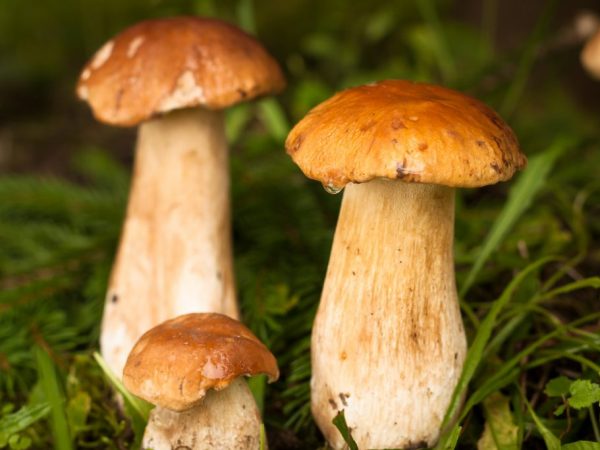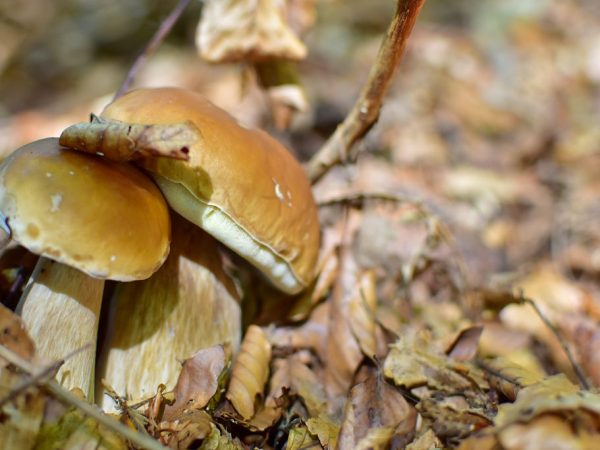Types of mushrooms in the Gomel region
The ancient Romans considered mushrooms to be the food of the gods. They were cooked and served in noble houses only on holidays. For residents of the Gomel region, mushrooms are an integral part of the diet that everyone can afford. In the forests of Belarus, they are harvested from spring to late autumn, and some species are found in winter.

Types of mushrooms in the Gomel region
Main characteristics
All forest mushrooms, and there are more than 200 of them in the region, are divided into 4 main categories: edible, inedible, poisonous and conditionally edible. There are 20-30 types of edible mushrooms in the area and are eaten in a wide variety of mushroom dishes.
1st taste category: it includes edible russula, champignons and white, they do not need to be heat treated and are used raw for salads and other dishes. Their taste and useful properties are preserved after freezing or drying.
2nd flavor category: it includes boletus boletus, aspen mushrooms, less aromatic mushrooms and boletus, etc. They have a bright taste, they are used for preparing side dishes and aperitifs, sometimes used for salting.
3rd category: mushrooms, mushrooms and morels have a weak aroma and average taste, which is why they were included in this category. They are usually used for making mushroom pates or snacks.
4th category: the mushrooms included in its composition are characterized by the lowest taste. This category is considered specific and its representatives are used only for pickling and pickling. It includes mushrooms, millers and other conditionally edible mushrooms.
Edible species of the Gomel region
In spring in Gomel forests it is impossible to find white, and in autumn morels, because all mushrooms grow in a certain season:
- spring;
- summer;
- autumn;
- winter.
The most popular in this region are morels, white, boletus, brown oak, boletus, boletus, chanterelle mushrooms, mushrooms, mushrooms and mushrooms.
In birch groves in the spring, morels and lines with original hats appear on last year's leaves.
Closer to summer, boletus - tubular mushrooms with a smooth brown cap covered with mucus begin to "climb" out of the ground. Light creamy pulp which has a pleasant aroma.
White and boletus are considered the kings of the forest. They meet from July to October. In total, there are 5 varieties of these mushrooms in Belarus. Their hat is brown or beige, which depends on the soil and other conditions of development. The pulp is dense, homogeneous, white, does not change color at the break.
Polish mushrooms grow in conifers. They have a matte brown velvet hat. On the cut, the color changes to yellowish or blue.
Champignons grow from June to October. These representatives of the lamellar species have a pleasant aroma and light pulp, which becomes pale pink at a break. Small scales are visible on the cap. There is a film under the cap - the remains of the bedspread, which is tightly connected in young specimens with a cylindrical leg.

The forests of the area are rich in mushrooms
Ryzhiks are lamellar mushrooms of an unusual shape.On the cut, a reddish milky juice, pleasant to smell and taste, appears. If you press on the plates, they turn brown and then green.
In the oak groves of this area, oak woods or common oak trees, belonging to the tubular mushrooms, are often found. The shape of their caps resembles half a yellowish-brown ball. When cut, the flesh turns blue. The aroma is strong and pleasant. Fry or stew poddubiks well.
Summer and autumn mushrooms have about 5 varieties on the territory of the Gomel region. They always grow in large numbers. They prefer shady places, mossy stumps and damaged fallen trunks of old trees. The hats have the shape of a dome or a ball, they are held on a thin leg, which sometimes reaches 20 cm in height.
Inedible and poisonous species
The area map also displays poisonous counterparts:
- death cap;
- gall mushroom;
- the chanterelle is false;
- false foaming;
- pepper mushroom.
The gall mushroom resembles white and boletus in appearance. If you look closely, you will see a fine black mesh and tubules of the hymenophore that are pink, not yellowish-green, like the edible original, on the stem. Its smell and taste are unpleasant, betraying the presence of toxins.
Another poisonous species in this area is the pale grebe, which is often confused with honey agarics and young mushrooms. It differs from honey agarics by the absence of a "skirt" on the leg, as well as by a tuberous extension at the base of the leg, which is also covered with volva. The largest number of deaths was recorded from this particular fungus. With one touch, its toxins are absorbed into the skin and transferred into the bloodstream, causing vomiting, diarrhea, hallucinations and fever.
Irina Selyutina (Biologist):
Unfortunately, pale toadstool is confused with a number of edible mushrooms (variegated umbrella mushroom, champignons, greenfinches and russula) despite the characteristic appearance:
- hat: olive greenish;
- leg: has a tuberous base;
- foot ring: firmly attached 2/3 of the height from the base.
In the fruiting body of the pale toadstool, there are 3 groups of specific toxins that are resistant to high temperatures and do not collapse during prolonged heat treatment:
- amatoxins (α-, β-, γ-amanitin): responsible for organ damage. The lethal dose for humans is 0.1-0.3 mg / kg of body weight;
- phalloidins;
- phallolysins.
The last two groups with the common name phallotoxins are alkaloids present in the leg of the pale toadstool and the stinking fly agaric. They destroy the mucous membrane of the stomach and intestines within 6-8 hours, which significantly accelerates the absorption of amatoxins.
Ephedra are places of growth of talkers or false chanterelles. They have an orange cap that attracts attention, but differ from the real ones in brighter plates and yellowish or pink flesh at the break.
Mushroom places
Mushroom spots are found throughout the area.
- Svetlogorsk, Svetlogorsk district: not far from it there are many chanterelles, boletus and porcini mushrooms. Get there by bus Gomel-Svetlogorsk.
- village Chizhovka, Rechitsa district: there are large meadows of honey agarics here. Their families come across on the way from the station to the forest. The region is characterized by large honey agaric harvests.
- Gomel forestry enterprise: boletus, white, boletus, etc. grow on its territory.
- Shabrinsky forest: it is not recommended to go further than this massif, there is a risk of stumbling upon radioactive mushrooms, as in the Dobrushinsky and Romanovichsky forestries.
- village Zhuravlevka, Gomel district: it contains places with chanterelles.
- villages Shcherbovka / Chizhovka, Gomel region: many porcini mushrooms. Get by train from Gomel towards Rechitsa / Kalinkovichi.
Conclusion
It is pleasant to walk in the forest and harvest delicious crops at any time of the year. It is necessary to remember the collection rules and observe safety measures. It is important to have a sharp knife, personal protective equipment against mosquitoes and ticks, and a ventilated basket with you.



